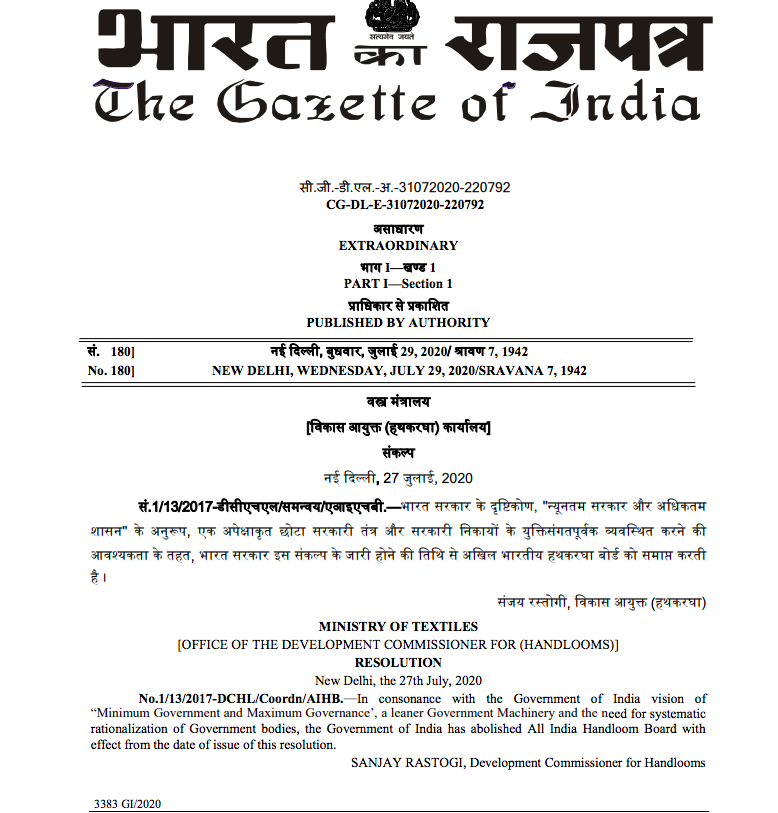Handloom and Handicrafts Boards Abolished: ‘Modernising India at the Cost of Bharat’, say Activists
As India marks the sixth National Handloom Day today, the 70-year-old All India Handicrafts Board and the All India Handloom Board – the biggest interface between the nation’s artisans and the government – stand abolished. While the handicrafts board was constituted by over 80 non-bureaucratic members, prior to its dissolution the handloom board had 114 members.
In a gazette notification released on July 27, the Centre announced: “In consonance with the Government of India vision of ‘Minimum Government and Maximum Governance’, a leaner Government Machinery and the need for systematic rationalization of Government bodies, the Government of India has abolished All India Handloom Board.”

In another notification on August 3, the Centre provided the same reason for doing away with the All India Handicrafts Board.
The handicrafts board “gives its advice to the government in formulation of the overall Development Programmes in the Handicrafts Sector, keeping in view socio-Economic cultural and artistic perspective. (sic),” the Ministry of Textiles said on its website.
The Centre’s moves have been slammed by activists across the board, who say that it is dangerous and oriented towards the suppression of the voices of millions of artisans from rural India, who were represented through these forums.
Speaking to NewsClick, D.Narsimha Reddy, policy expert and activist, said: “The board does not cost much to the government; as per mandate they had to have the meetings twice a year. It was to be the interface between the government and the people, and a constant means of communication. The government is distancing itself from the sector. The sector has enormous turnover, higher than other sectors and contributes to rural employment. The government is aiming to modernise India at the cost of Bharat.”
Nearly 2.8 million households in India, the majority of them rural, were involved in handloom work, according to the Third National Handloom Census of Weavers and Allied Workers, 2010. A large part of these workers were women.
Activists have highlighted the severe livelihood crisis faced by the workers. Despite being highly skilled and capable of widely-appreciated products, income flow has been an issue for families dependent on handloom weaving. Moreover, the pandemic and the lockdown have been extremely unkind to these families.
Prior to the abolishment of the boards, activists had alleged that the annual Handloom Budget allocations have been witnessing a cut over the years, with board meetings rarely taking place.
While the Modi Government extensively promotes its ‘Make in India’ campaign, the crafts-persons working in the sector featured nowhere in the government’s Atma Nirbhar package.
Activists have labelled the move a “gross injustice” to lakhs of families. Taking to Facebook, activist and chairperson of Dastkar, an NGO, Laila Tyabji said: “The given rationale for ‘abolishing’ it (the notification is stark – it doesn’t say ‘re-constituting’ it, or ‘dissolving’ it) is that the move is ‘in consonance with the Govt’s vision of Minimum Government and Maximum Governance’ and ‘a leaner Government machinery’.
Spaces where people can interact directly with the Government, or be part of their own governance, are certainly becoming leaner and increasingly few in number. Speaking to NewsClick, she added: “I will be waiting for some announcements to be made around the handloom day, post which the voices against the abolishment of the handicrafts board are expected to grow louder.”
Crafts activist and filmmaker, Swati Kavula, said: “The sector has already been in a big mess, with the livelihoods of many on the line. What was required by the government was to give the sector protection. Mr. Modi says wear Khadi and then he brought in policies such as demonetisation which have completely crushed artisans – and then this move. They have been mixing the ministry of textiles up with handloom; now the handlooms might be taken out and only the textile ministry will remain functioning at the behest of Surat mills and corporates.”
Activists are demanding a reconstitution of the All India Handloom Board, saying that the board needs to be strengthened with a mandate reflecting the needs of policy-making, monitoring, review and public hearing functions.
Also Read: COVID-19 Lockdown Last Nail in Coffin for Crisis-hit Zaidpur Handloom Industry
Get the latest reports & analysis with people's perspective on Protests, movements & deep analytical videos, discussions of the current affairs in your Telegram app. Subscribe to NewsClick's Telegram channel & get Real-Time updates on stories, as they get published on our website.






















